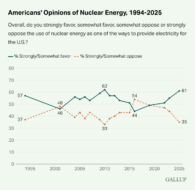The Nuclear Energy Institute has issued its state of the nuclear energy industry, and prospects are good.
In the keynote address at the Nuclear Energy Policy Forum this week, NEI President Maria Korsnick gave the association’s yearly update on the nuclear energy industry’s progress and its growth priorities for the years ahead.
“The reason behind this race towards nuclear is simple,” Korsnick said. “The world needs more power, and we need it sooner than projected.”
Building better: As a nuclear publication, we can wholeheartedly confirm one fact: There is so much happening in the nuclear energy sector. Contracts are being signed, companies are going public, reactors are coming online, and grants are being…granted—at what sometimes feels like a daily rate.
Korsnick gave a rundown of recent projects that have made headway in the past year. We can’t rehash it all in one measly email, but here’s a short list:
- Vogtle Units 3 and 4 began commercial operations.
- Oklo and NANO Nuclear hit the public markets last week via SPAC merger and IPO, respectively.
- Microsoft, Google, and Nucor partnered on the Advanced Clean Electricity initiative to deploy commercial nuclear.
- AWS purchased a data center campus that hooks into an existing nuclear plant.
“These companies are sending a clear signal to the marketplace: Demand for carbon-free power is up—and specifically nuclear—and it’s strong and growing,” Korsnick said. “It’s exciting to see how the energy industry is using the clean energy transition to forge new business models.”
Where it all starts: The fuel pipeline has been a potential vulnerability for the sector. The US is working to ease its dependence on Russia for the enriched uranium needed to power its fleet of reactors.
- A recent uranium ban, which was signed into law this week, frees up $2.7B in federal funding to build a domestic HALEU pipeline.
“In this moment, we can’t continue to power our country, let alone the world, on the backs of Russian uranium,” Korsnick said. “Reshoring the fuel production to American soil is an imperative for our future.”
Work it: As the nuclear energy industry expands, the nuclear workforce will need to grow with it. The DOE projects that by 2050, the advanced nuclear sector alone will create 375,000 additional jobs across manufacturing and operations.
- Korsnick emphasized the potential for nuclear plants to replace retiring coal plants and provide well-paying jobs to former coal industry workers.
The upshot: That’s a lot of things on the to-do list, and such ambitious time- and capital-intensive projects will require continued governmental support and speedier regulatory processes.
“We need to ensure that we help early movers move,” Korsnick said. “It’s hard to lead the pack, and it takes more than just courage. We need incentives, grants, and cost mitigation to help make it easier to take that leap.”
Lead Reporter of Ignition





